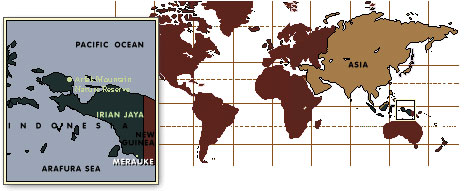
Arfak Mountains Nature Reserve

Arfak Mountains Nature Reserve (approx. 63,000 ha) undoubtedly holds the greatest source of rare and endemic taxa in New Guinea. Of the 130 rare and endemic mountain bird species of mainland New Guinea, the highest number occurs in the Bird's Head Peninsula, with 51 forms compared with 33 in the Central Mountain Range. This reserve contains about 320 birds and 90 mammals. Though it is primarily mountain reserve, all contain corridors into the lowlands and are complete ecological units.
 The
Arfak mountains are also the world's center of biodiversity for the famous
bird-wing butterflies. Irian Jaya contains a
substantial proportion of incredibly diverse and colorful insect fauna of New
Guinea - conservatively estimated at over 50,000 species, of which more than
5,000 are butterflies and moths (Lindgren, 1975). The insects are one of
the least-studied groups, which not only offer an opportunity for biological
research but also have a tremendous potential for bringing economic assistance
to rural peoples. Some of the most spectacular forms, the large bird-wing
butterflies (Ornithopterids), have their world's center of diversity in the
Arfak-Anggi region of this province. But butterflies, moths and an immense
array of beetles - including may commercial species - occur in other major
habitat in Irian Jaya. A rational utilization of these species can reach
out to the most isolated communities in the region and thus has a great
potential for rural assistance than other farming.
The
Arfak mountains are also the world's center of biodiversity for the famous
bird-wing butterflies. Irian Jaya contains a
substantial proportion of incredibly diverse and colorful insect fauna of New
Guinea - conservatively estimated at over 50,000 species, of which more than
5,000 are butterflies and moths (Lindgren, 1975). The insects are one of
the least-studied groups, which not only offer an opportunity for biological
research but also have a tremendous potential for bringing economic assistance
to rural peoples. Some of the most spectacular forms, the large bird-wing
butterflies (Ornithopterids), have their world's center of diversity in the
Arfak-Anggi region of this province. But butterflies, moths and an immense
array of beetles - including may commercial species - occur in other major
habitat in Irian Jaya. A rational utilization of these species can reach
out to the most isolated communities in the region and thus has a great
potential for rural assistance than other farming.
 Historically,
Arfak mountains is the first region to undergo extensive zoological exploration
in 1872-1873 by d'Albertis and Beccari. They hold the type localities from
where much original biological material was collected and described.
On the other hand, the mountain and surround are heavily populated, and, even
though considerable pains were taken in the boundary design to exclude major
settlements, the reserve is under the threat of population expansion. The
transmigration settlements established in Oransbari and Prafi, rubber and cocoa
plantation expansion along the east coast are other reasons to concern, although
the plantations can be employed as a useful buffer zone by coordinating their
planning with the reserve. Therefore, Arfak considered of priority
importance.
Historically,
Arfak mountains is the first region to undergo extensive zoological exploration
in 1872-1873 by d'Albertis and Beccari. They hold the type localities from
where much original biological material was collected and described.
On the other hand, the mountain and surround are heavily populated, and, even
though considerable pains were taken in the boundary design to exclude major
settlements, the reserve is under the threat of population expansion. The
transmigration settlements established in Oransbari and Prafi, rubber and cocoa
plantation expansion along the east coast are other reasons to concern, although
the plantations can be employed as a useful buffer zone by coordinating their
planning with the reserve. Therefore, Arfak considered of priority
importance.
Quoted from Petocz, R.G. (1987), Conservation and Development in Irian Jaya.
Copyright © 2000 Conservation Science Department WWF Indonesia - Sahul Bioregion